比较文学翻译
- 格式:ppt
- 大小:486.50 KB
- 文档页数:33
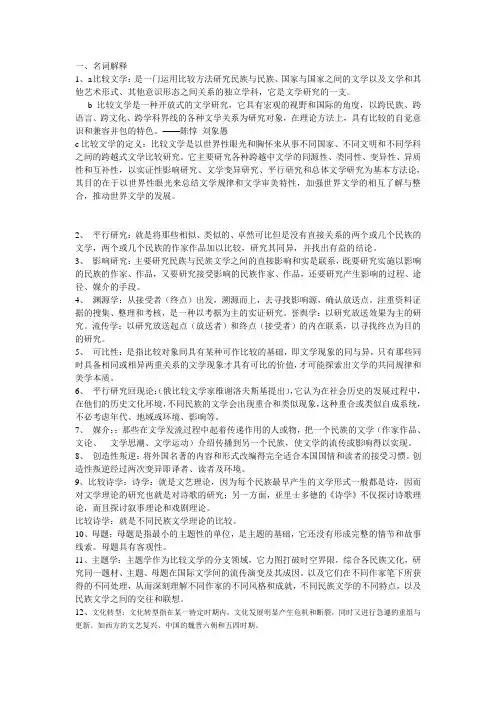
一、名词解释1、a 比较文学:是一门运用比较方法研究民族与民族、国家与国家之间的文学以及文学和其他艺术形式、其他意识形态之间关系的独立学科,它是文学研究的一支。
b比较文学是一种开放式的文学研究,它具有宏观的视野和国际的角度,以跨民族、跨语言、跨文化、跨学科界线的各种文学关系为研究对象,在理论方法上,具有比较的自觉意识和兼容并包的特色。
——陈惇刘象愚c比较文学的定义:比较文学是以世界性眼光和胸怀来从事不同国家、不同文明和不同学科之间的跨越式文学比较研究。
它主要研究各种跨越中文学的同源性、类同性、变异性、异质性和互补性,以实证性影响研究、文学变异研究、平行研究和总体文学研究为基本方法论,其目的在于以世界性眼光来总结文学规律和文学审美特性,加强世界文学的相互了解与整合,推动世界文学的发展。
2、平行研究:就是将那些相似、类似的、卓然可比但是没有直接关系的两个或几个民族的文学,两个或几个民族的作家作品加以比较,研究其同异,并找出有益的结论。
3、影响研究:主要研究民族与民族文学之间的直接影响和实是联系,既要研究实施以影响的民族的作家、作品,又要研究接受影响的民族作家、作品,还要研究产生影响的过程、途径、媒介的手段。
4、渊源学:从接受者(终点)出发,溯源而上,去寻找影响源,确认放送点。
注重资料证据的搜集、整理和考核,是一种以考据为主的实证研究。
誉舆学:以研究放送效果为主的研究。
流传学:以研究放送起点(放送者)和终点(接受者)的内在联系,以寻找终点为目的的研究。
5、可比性:是指比较对象间具有某种可作比较的基础,即文学现象的同与异,只有那些同时具备相同或相异两重关系的文学现象才具有可比的价值,才可能探索出文学的共同规律和美学本质。
6、平行研究回现论:(俄比较文学家维谢洛夫斯基提出),它认为在社会历史的发展过程中,在他们的历史文化环境,不同民族的文学会出现重合和类似现象,这种重合或类似自成系统,不必考虑年代、地域或环境、影响等。

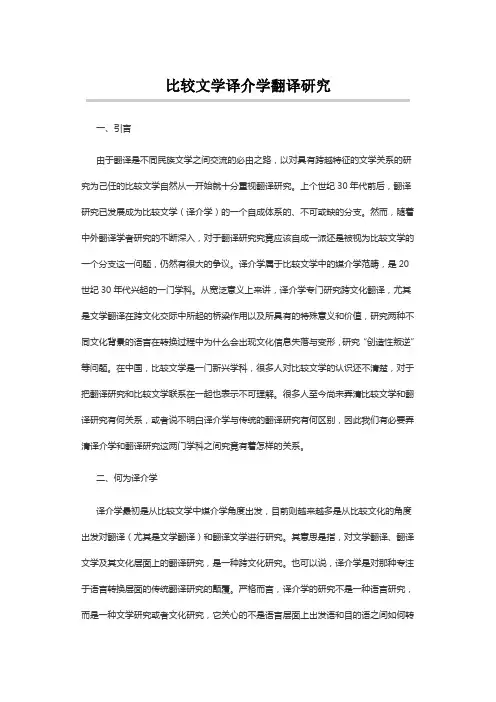
比较文学译介学翻译研究一、引言由于翻译是不同民族文学之间交流的必由之路,以对具有跨越特征的文学关系的研究为己任的比较文学自然从一开始就十分重视翻译研究。
上个世纪30年代前后,翻译研究已发展成为比较文学(译介学)的一个自成体系的、不可或缺的分支。
然而,随着中外翻译学者研究的不断深入,对于翻译研究究竟应该自成一派还是被视为比较文学的一个分支这一问题,仍然有很大的争议。
译介学属于比较文学中的媒介学范畴,是20世纪30年代兴起的一门学科。
从宽泛意义上来讲,译介学专门研究跨文化翻译,尤其是文学翻译在跨文化交际中所起的桥梁作用以及所具有的特殊意义和价值,研究两种不同文化背景的语言在转换过程中为什么会出现文化信息失落与变形,研究“创造性叛逆”等问题。
在中国,比较文学是一门新兴学科,很多人对比较文学的认识还不清楚,对于把翻译研究和比较文学联系在一起也表示不可理解。
很多人至今尚未弄清比较文学和翻译研究有何关系,或者说不明白译介学与传统的翻译研究有何区别,因此我们有必要弄清译介学和翻译研究这两门学科之间究竟有着怎样的关系。
二、何为译介学译介学最初是从比较文学中媒介学角度出发,目前则越来越多是从比较文化的角度出发对翻译(尤其是文学翻译)和翻译文学进行研究。
其意思是指,对文学翻译、翻译文学及其文化层面上的翻译研究,是一种跨文化研究。
也可以说,译介学是对那种专注于语言转换层面的传统翻译研究的颠覆。
严格而言,译介学的研究不是一种语言研究,而是一种文学研究或者文化研究,它关心的不是语言层面上出发语和目的语之间如何转换的问题,而是原文在这种外语和本族语转换过程中信息的失落、变形、增添、扩神等问题,它关心的是翻译(主要是文学翻译)作为人类一种跨文化交流的实践活动所具有的独特价值和意义。
由此可见,比较文学中的译介学研究是比较文学研究中语言、文字与文学性相结合的部分,主要指文学翻译、翻译文学以及文化层面上的翻译研究,也是把翻译作为一种跨语际交流实践所进行的跨文化研究。
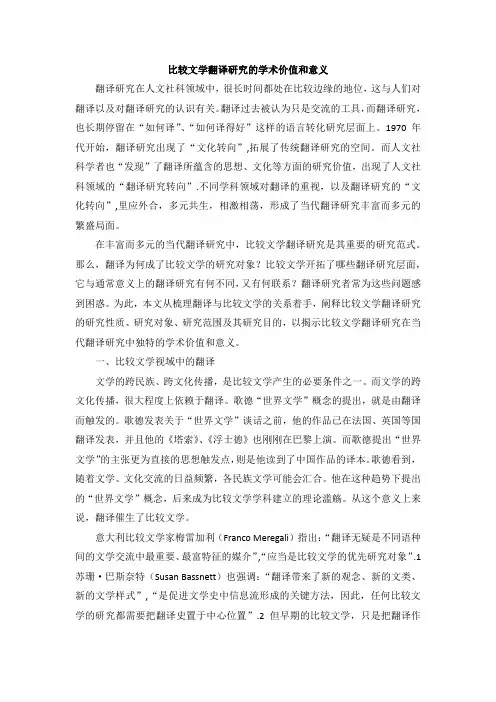
比较文学翻译研究的学术价值和意义翻译研究在人文社科领域中,很长时间都处在比较边缘的地位,这与人们对翻译以及对翻译研究的认识有关。
翻译过去被认为只是交流的工具,而翻译研究,也长期停留在“如何译”、“如何译得好”这样的语言转化研究层面上。
1970年代开始,翻译研究出现了“文化转向”,拓展了传统翻译研究的空间。
而人文社科学者也“发现”了翻译所蕴含的思想、文化等方面的研究价值,出现了人文社科领域的“翻译研究转向”.不同学科领域对翻译的重视,以及翻译研究的“文化转向”,里应外合,多元共生,相激相荡,形成了当代翻译研究丰富而多元的繁盛局面。
在丰富而多元的当代翻译研究中,比较文学翻译研究是其重要的研究范式。
那么,翻译为何成了比较文学的研究对象?比较文学开拓了哪些翻译研究层面,它与通常意义上的翻译研究有何不同,又有何联系?翻译研究者常为这些问题感到困惑。
为此,本文从梳理翻译与比较文学的关系着手,阐释比较文学翻译研究的研究性质、研究对象、研究范围及其研究目的,以揭示比较文学翻译研究在当代翻译研究中独特的学术价值和意义。
一、比较文学视域中的翻译文学的跨民族、跨文化传播,是比较文学产生的必要条件之一。
而文学的跨文化传播,很大程度上依赖于翻译。
歌德“世界文学”概念的提出,就是由翻译而触发的。
歌德发表关于“世界文学”谈话之前,他的作品已在法国、英国等国翻译发表,并且他的《塔索》、《浮士德》也刚刚在巴黎上演。
而歌德提出“世界文学”的主张更为直接的思想触发点,则是他读到了中国作品的译本。
歌德看到,随着文学、文化交流的日益频繁,各民族文学可能会汇合。
他在这种趋势下提出的“世界文学”概念,后来成为比较文学学科建立的理论滥觞。
从这个意义上来说,翻译催生了比较文学。
意大利比较文学家梅雷加利(Franco Meregali)指出:“翻译无疑是不同语种间的文学交流中最重要、最富特征的媒介”,“应当是比较文学的优先研究对象”.1 苏珊·巴斯奈特(Susan Bassnett)也强调:“翻译带来了新的观念、新的文类、新的文学样式”,“是促进文学史中信息流形成的关键方法,因此,任何比较文学的研究都需要把翻译史置于中心位置”.2 但早期的比较文学,只是把翻译作为考察文学传播和影响考据的线索。
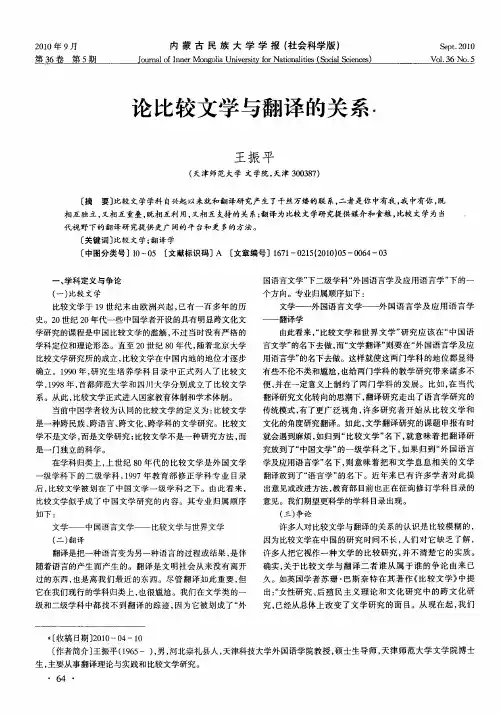
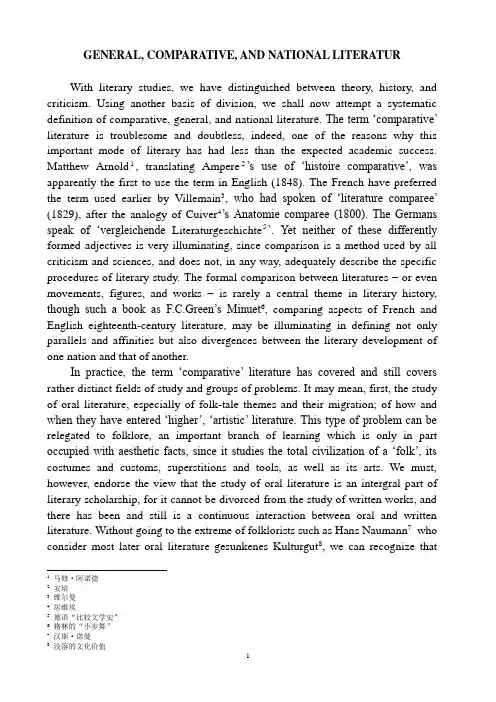
GENERAL, COMPARATIVE, AND NATIONAL LITERATURWith literary studies, we have distinguished between theory, history, and criticism. Using another basis of division, we shall now attempt a systematic definition of comparative, general, and national literatur e. The term ‘comparative’ literature is troublesome and doubtless, indeed, one of the reasons why this important mode of literary has had less than the expected academic success. Matthew Arnold1, translating Ampere2’s use of ‘histoire comparative’, was apparently the first to use the term in English (1848). The French have preferred the term used earlier by Villemain3, who had spoken of ‘literature comparee’ (1829), after the analogy of Cuiver4’s Anatomie comparee (1800). The Germans speak of ‘vergleichende Literaturgeschichte5’. Yet neither of these differently formed adjectives is very illuminating, since comparison is a method used by all criticism and sciences, and does not, in any way, adequately describe the specific procedures of literary study. The formal comparison between literatures – or even movements, figures, and works –is rarely a central theme in literary history, though such a book as F.C.Green’s Minuet6, comparing aspects of French and English eighteenth-century literature, may be illuminating in defining not only parallels and affinities but also divergences between the literary development of one nation and that of another.In practice, the term ‘comparative’ literature has covered and still covers rather distinct fields of study and groups of problems. It may mean, first, the study of oral literature, especially of folk-tale themes and their migration; of how and when they have entered ‘higher’, ‘artistic’ literature. This type of problem can be relegated to folklore, an important branch of learning which is only in part occupied with aesthetic facts, since it studies the total civilization of a ‘folk’, its costumes and customs, superstitions and tools, as well as its arts. We must, however, endorse the view that the study of oral literature is an intergral part of literary scholarship, for it cannot be divorced from the study of written works, and there has been and still is a continuous interaction between oral and written literature. Without going to the extreme of folklorists such as Hans Naumann7who consider most later oral literature gesunkenes Kulturgut8, we can recognize that1马修·阿诺德2安培3维尔曼4居维埃5德语“比较文学史”6格林的“小步舞”7汉斯·诺曼written upper-class literature has profoundly affected oral literature. On the other hand, we must assume the folk origin of many basic literary genres and themes, and we have abundant evidence for the social rise of folk literature. Still, the incorporation into folklore of chivalric romance and troubadour lyric is an indubitable fact. Though this is a view which would have shocked the Romantic believers in the creativity of the folk and the remote antiquity of folk art, nevertheless popular ballads, fairy tales, and legends as we know them are frequently of late origin and upper-class derivation. Yet the study of oral literature must be an important concern of every literary scholar who wants to understand the process of literary development, the origin and the rise of our literary genres and devices. It is unfortunate that the study of oral literature has thus far been so exclusively preoccupied with the study of themes and their migrations from country to country, i.e. with the raw materials of modern literatures. Of late, however, folklorists have increasingly turned their attention to the study of patterns, forms, and devices, to a morphology1of literary forms, to the problems of the teller and narrator and the audience of a tale, and have thus prepared the way for a close integration of their studies into a general conception of literary scholarship. Though the study of oral literature has its own peculiar problems, those of transmission and social setting, its fundamental problems, without doubt, are shared with written literature; and there is a continuity between oral and written literature which has never been interrupted. Scholars in the modern European literatures have neglected these questions to their own disadvantage, while literary historians in the Slavic and Scandinavian countries, where folklore is still – or was till recently –alive, have been in much closer touch with these studies. But ‘comparative literature’ is hardly the term by which to designate the study of oral literature.Another sense of ‘comparative’ literature confines it to the study of relationships between two or more literatures. This is the use established by the flourishing school of French comparatists headed by the late Fernand Baldensperger2and gathered around the Revue de literature comparee3. The school has especially given attention, sometimes mechanically but sometimes with considerable finesse, to such questions as the reputation and penetration, the influence and fame, of Goethe in France and England, of Ossian4and Carlyle51形态2巴登斯贝格3《比较文学评论》4哦相and Schiller1in France. It has developed a methodology which, going beyond the collection of information concerning reviews, translations, and influences, considers carefully the image, the concept of a particular author at a particular time, such diverse factors of transmission as periodicals, translators, salons, and travelers, and the ‘receiving factor’“接待因子”, the special atmosphere and literary situation into which the foreign author is imported. In total, much evidence for the close unity, especially of the Western European literatures has been accumulated; and our knowledge of the ‘foreign trade对外贸易’ of literatures has been immeasurably increased.But this conception of ‘comparative literature’ has also, one recognizes, its peculiar difficulties. No distinct system can, it seems, emerge from the accumulation of such studies. There is no methodological distinction between a study of ‘Shakespeare in France’ and a study of ‘Shakespeare in eighteen-century England’, or between a study of Poe爱伦坡’s influence on Baudelaire波德莱尔and one of Dryden德莱顿’s influence on Pope. Comparisons between literatures, if isolated from concern with the total national literatures, tend to restrict themselves to external of sources and influences, reputation and fame. Such studies do not permit us to analyse and judge an individual work of art, or even to consider the complicated whole of its genesis; instead, they are mainly devoted either to such echoes of a masterpiece as translations and imitations, frequently by second-rate authors, or to the prehistory of a masterpiece, the migrations and the spread of its themes and forms. The emphasis of ‘comparative literature’ thus c onceived is on externals; and the decline of this type of ‘comparative literature’ in recent decades reflects the general turning away from stress on mere ‘facts’, on sources and influences.A third conception obviates, however, all these criticisms, by identifying ‘comparative literature’ with the study of literature in its totality, with ‘world literature’, with ‘general’ or ‘universal’ literature. There are certain difficulties with these suggested equations. The term ‘world literature’, a translation of Goethe歌德’s Weltliteratur, is perhaps needlessly grandiose, implying that literature should be studied on all five continents, from New Zealand to Iceland. Goethe, actually, had no such thing in mind. ‘World literature’ was used by him to indicate a time w hen all literatures would become one. It is the ideal of the unification of all literatures into one great synthesis, where each nation would play its part in a universal concert. But Goethe himself saw that this is a very distant ideal, that no single nation is willing to give up its individuality. Today we are possibly even furtherremoved from such a state of amalgamation, and we would argue that we cannot even seriously wish that the diversities of national literatures should be obliterated. ‘World literature’ is frequently used in a third sense. It may mean the great treasure-house of the classics, such as Homer, Dante, Cervantes, Shakespeare, and Goethe, whose reputation has spread all over the world and has lasted a considerable time. It thus has beco me a synonym for ‘masterpieces’, for a selection from literature which has its critical and pedagogic justification but can hardly satisfy the scholar who cannot confine himself to the great peaks if he is to understand the whole mountain ranges or, to drop the figure, all history and change.The possibly preferable term ‘general literature’ has other disadvantages. Originally it was used to mean poetics or theory and principles of literature, and in recent decades Paul Van Tieghem has tried to capture it for a special conception in contrast to ‘comparative literature’. According to him, ‘general literature’ studies those movements and fashions of literature which transcend national lines, while ‘comparative literature’ studies the interrelationships between two or more literatures. But how can we determine whether, e.g. Ossianism is a topic of ‘general’ or ‘comparative literature’? One cannot make a valid distinction between the influence of Walter Scott abroad and the international vogue of the historical n ovel. ‘Comparative’ and ‘general’ literature merge inevitably. Possibly, it would be best to speak simply of ‘literature’.Whatever the difficulties into which a conception of universal literary history may run, it is important to think of literature as a totality and to trace the growth and development of literature without regard to linguistic distinctions. The great argument for ‘comparative’ or ‘general’ literature or just ‘literature’ is the obvious falsity of the idea of a self-enclosed national literature. Western literature, at least, forms a unity, a whole. One cannot doubt the continuity between Greek and Roman literatures, the Western medieval world, and the main modern literatures; and, without minimizing the importance of Oriental influences, especially that of the Bible, one must recognize a close unity which includes all Europe, Russia, the United States, and the Latin-American literatures. This ideal was envisaged and, within their limited means, fulfilled, by the founders of literary history in the early nineteenth century: such men as the Schlegels史雷格尔兄弟, Bouterwek布特维克, Sismondi西斯蒙第, and Hallam哈勒姆. But then the further growth of nationalism combined with the effect of increasing specialization led to an increasingly narrow provincial cultivation of the study of national literatures. During the second half of the nineteenth century the ideal of a universal literarypractitioners of ‘comparative literature’ were folklor ists, ethnographers who, largely under the influence of Herbert Spencer, studied the origins of literature, its diversification in oral literary forms, and its emergence into the early epic, drama, and lyric. Evolutionism left, however, few traces on the history of modern literatures and apparently fell into discredit when it drew the parallel between literary change and biological evolution too closely. With it the ideal of universal literary history declined. Happily, in recent years there are many signs which augur a return to the ambition of general literary historiography. Ernst Robert Curtius’s科修斯European Literature and the Latin Middle Ages《欧洲文学与拉丁中古时代》(1948), which traces commonplaces through the totality of Western tradition with stupendous erudition, and Erich Auerbach埃利希·奥尔巴赫’s Mimesis模仿论(1946), a history of realism from Homer to Joyce based on sensitive stylistic analyses of individual passages, are achievements of scholarship which ignore the established nationalisms and convincingly demonstrate the unity of Western civilization, the vitality of the heritage of classical antiquity and medieval Christianity.Literary history as a synthesis, literary history on a super-national scale, will have to be written again. The study of comparative literature in this sense will make high demands on the linguistic proficiencies of our scholars. It asks for a widening of perspectives, a suppression of local and provincial sentiments, not easy to achieve. Yet literature is one, as art and humanity are one; and in this conception lies the future of historical literary studies.Within this enormous area – in practice, identical with all literary history – there are, no doubt, subdivisions somtimes running along linguistic lines. There are, first of all, the groups of the three main linguistic families in Europe –the Germanic, the Romance, and the Slavic literatures. The Romance literatures have particularly frequently been studied in close interconnection, from the days of Bouterwek up to Leonardo Olschki’s 奥尔式基attempt to write a history of them all for the medieval period. The Germanic literatures have been comparably studied, usually, only for the early Middle Ages, when the nearness of a general Teutonic条顿civilization, can be still strongly felt. Despite the customary opposition of Polish scholars, it would appear that the close linguistic affinities of the Slavic languages, in combination with shared popular traditions extending even to metrical forms, make up a basis for a common Slavic literature.The history of themes and forms, devices and genres, is obviously an international history. While most of our genres descend from the literature of Greece and Rome, they were very considerably modified and augmented duringindividual linguistic systems, is international. Furthermore, the great literary movements and styles of modern Europe (the Renaissance, the Baroque, Neo-Classicism, Romanticism, Realism, Symbolism) far exceed the boundaries of one nation, even though there are significant national differences between the working out of these styles. Also their geographical spread may vary. The Renaissance, e.g. penetrated to Poland but not to Russia or Bohemia. The Baroque style flooded the whole of Eastern Europe including the Ukraine, but hardly touched Russia proper. There may be also considerable chronological divergences: the Baroque style survived in the peasant civilizations of Eastern Europe well to the end of the eighteenth century when the West has passed through the Enlightenment, and so on. On the whole, the importance of linguistic barriers was quite unduly magnified during the nineteenth century.This emphasis was due to the very close association between Romantic (mostly linguistic) nationalism and the rise of modern organized literary history. It continues today through such practical influences as the virtual identification, especially in the United States, of the teaching of literature and the teaching of a language. The result, in the United States, has been an extraordinary lack of contact between the students of English, German, and French literature. Each of these groups bears a completely different imprint and uses different methods. These disjunctions are in part, doubtless, unavoidable, simply because most men live in but a single linguistic medium; and yet they lead to grotesque consequences when literary problems are discussed only with regard to views expressed in the particular language and only with reference to texts and documents in that language. Though in certain problems of artistic style, metre, and even genre, the linguistic differences between the European literatures will be important, it is clear that for many problems of the history of ideas, including critical ideas, such distinctions are untenable; artificial cross-sections are drawn through homogeneous materials, and histories are written concerning ideological echoes by chance expressed in English or German or French. The excessive attention to one vernacular is especially detrimental to the study of medieval literature, since in the Middle Ages Latin was the foremost literary language, and Europe formed a very close intellectual unity. A history of literature during the Middle Ages in England which neglects the vast amount of writings in Latin and Anglo-Norman gives a false picture of England’s literary situation and general culture.This recommendation of comparative literature does not, of course, imply neglecting the study of individual national literatures. Indeed, it is just the problem of ‘nationality’ and of the distinct contributions of the individual nationsstudied with theoretical clarity, the problem has been blurred by nationalistic sentiment and racial theories. To isolate the exact contributions of English literature to general literature, a fascinating problem, might lead to a shift of perspective and an altered evaluation, even of the major figures. Within each national literature there arise similar problems of the exact shares of regions and cities. Such an exaggerated theory as that of Josef Nadler约瑟夫·拿德勒, who professes to be able to discern the traits and characteristics of each German tribe and region and its reflections in literature, should not deter us from the consideration of these problems, rarely investigated with any command of facts and any coherent method. Much that has been written on the role of New England, the Middle East, and the South in the history of American literature, and most of the writings on regionalism, amounts to no more than the expression of pious hopes, local pride, and resentment of centralizing powers. Any objective analysis will have to distinguish questions concerning provenance and setting from questions concerning the actual influence of the landscape and questions of literary tradition and fashion.Problems of ‘nationality’ become especially complicated if we have to decide that literatures in the same language are distinct national literatures, as American and modern Irish assuredly are. Such a question as why Goldsmith高尔德斯密斯, Sterne斯特恩, and Sheridan沙瑞顿do not belong to Irish literature, while Yeats叶芝and Joyce乔伊斯do, needs an answer. Are there independent Belgian, Swiss, and Austrian literatures? It is not very easy to determine the point at which literature written in America ceased to be ‘colonial English’ and became an independent national literature. Is it the mere fact of political independence? Is it the national consciousness of the authors themselves? Is it the use of national subject-matter and ‘local color’地方色彩? Or is it the rise of a definite national literary style?Only when we have reached decisions on these problems shall we be able to write histories of national literature which are not simply geographical or linguistic categories, shall we be able to analyse the exact way in which each national literature enters into European tradition. Universal and national literatures implicate each other. A pervading European convention is modified in each country: there are also centres of radiation in the individual countries, and eccentric and individually great figures who set off one national tradition from the other. To be able to describe the exact share of the one and the other would amount to knowing much that is worth knowing in the whole of literary history.。
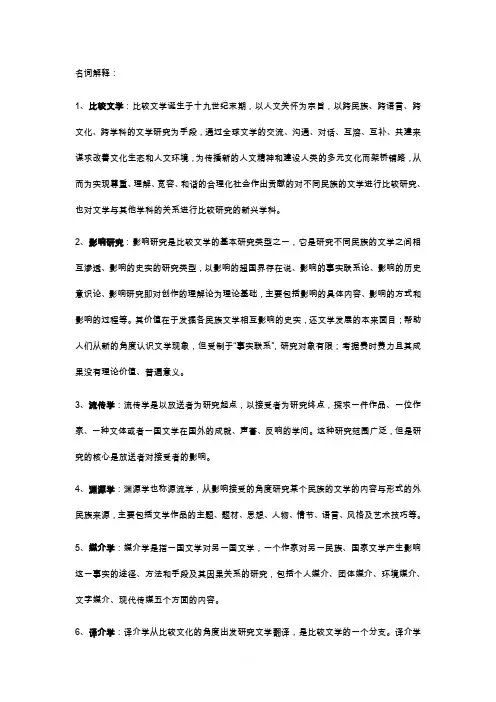
名词解释:1、比较文学:比较文学诞生于十九世纪末期,以人文关怀为宗旨,以跨民族、跨语言、跨文化、跨学科的文学研究为手段,通过全球文学的交流、沟通、对话、互溶、互补、共建来谋求改善文化生态和人文环境,为传播新的人文精神和建设人类的多元文化而架桥铺路,从而为实现尊重、理解、宽容、和谐的合理化社会作出贡献的对不同民族的文学进行比较研究、也对文学与其他学科的关系进行比较研究的新兴学科。
2、影响研究:影响研究是比较文学的基本研究类型之一,它是研究不同民族的文学之间相互渗透、影响的史实的研究类型,以影响的超国界存在说、影响的事实联系论、影响的历史意识论、影响研究即对创作的理解论为理论基础,主要包括影响的具体内容、影响的方式和影响的过程等。
其价值在于发掘各民族文学相互影响的史实,还文学发展的本来面目;帮助人们从新的角度认识文学现象,但受制于“事实联系”,研究对象有限;考据费时费力且其成果没有理论价值、普遍意义。
3、流传学:流传学是以放送者为研究起点,以接受者为研究终点,探求一件作品、一位作家、一种文体或者一国文学在国外的成就、声誉、反响的学问。
这种研究范围广泛,但是研究的核心是放送者对接受者的影响。
4、渊源学:渊源学也称源流学,从影响接受的角度研究某个民族的文学的内容与形式的外民族来源,主要包括文学作品的主题、题材、思想、人物、情节、语言、风格及艺术技巧等。
5、媒介学:媒介学是指一国文学对另一国文学,一个作家对另一民族、国家文学产生影响这一事实的途径、方法和手段及其因果关系的研究,包括个人媒介、团体媒介、环境媒介、文字媒介、现代传媒五个方面的内容。
6、译介学:译介学从比较文化的角度出发研究文学翻译,是比较文学的一个分支。
译介学的研究范畴:翻译造成的原文信息的失落、增加、变形现象、翻译文学(翻译中的创造性叛逆)两个方面,指将外国文学译介到本国译本及评介文字。
在比较文学中是指对文学交流中翻译的研究,以前是从媒介学出发,而目前则越来越多是从比较文化的角度出发来对翻译(尤其是文学翻译)和翻译文学进行的研究。



论比较文学翻译研究比较文学翻译研究:跨文化交流与文学传播的重要途径关键词:比较文学,翻译,研究,跨文化交流,文学传播引言随着全球化的推进和世界文学的快速发展,比较文学翻译研究日益成为学术界的热点。
比较文学翻译研究不仅文学作品的翻译和传播,还涉及不同文化间的理解和交流。
本文将概述比较文学翻译研究的现状、方法、成果与不足,以及未来研究的意义和方向。
文献综述近年来,比较文学翻译研究取得了丰硕的成果。
学者们从不同角度探讨了文学作品在跨文化语境下的传播与接受、翻译的创造性与忠实性、以及跨文化交际中的障碍与对策等问题。
然而,现有研究仍存在不足之处,如对比较文学翻译的动态过程和复杂性认识不足,以及缺乏对翻译实践中多元文化的等。
研究方法比较文学翻译研究通常采用文本分析、比较分析、历史分析等方法。
文本分析翻译文本的内在特征、翻译策略的选择以及译者的主体性等;比较分析则对比不同文化背景下的文学作品及其翻译,揭示跨文化交际中的差异与共性;历史分析则探究翻译历史的发展演变及其社会文化背景。
这些方法各有优点,但也存在一定的局限性。
成果与不足研究成果方面,比较文学翻译研究为我们提供了丰富的理论资源与实践经验。
通过对翻译过程中的文化碰撞与融合、译者的身份认同以及读者接受等问题的探讨,该研究为跨文化交流与文学传播提供了有力支持。
然而,现有研究仍存在不足,如对比较文学翻译的动态性和复杂性认识不足,以及缺乏对翻译实践中多元文化的等。
结论比较文学翻译研究是跨文化交流与文学传播的重要途径。
本文从关键词、引言、文献综述、研究方法、成果与不足以及结论等方面对比较文学翻译研究进行了全面梳理。
尽管该领域已经取得了显著成果,但仍有诸多问题值得进一步探讨。
未来研究应加强对比较文学翻译的动态过程和复杂性的认识,翻译实践中多元文化视角的介入,以及拓展对新兴翻译理论和实践的研究。
比较文学翻译研究在全球化背景下将发挥更加重要的作用,为世界范围内的文化交流与文学传播提供更多启示与实践指导。
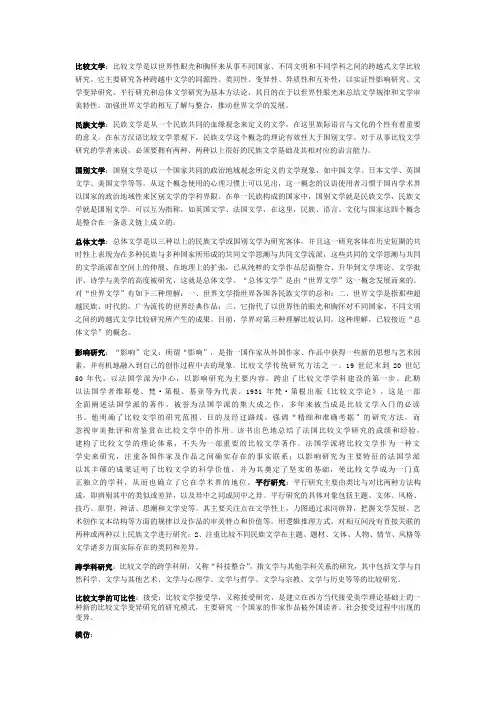
比较文学:比较文学是以世界性眼光和胸怀来从事不同国家、不同文明和不同学科之间的跨越式文学比较研究。
它主要研究各种跨越中文学的同源性、类同性、变异性、异质性和互补性,以实证性影响研究、文学变异研究、平行研究和总体文学研究为基本方法论,其目的在于以世界性眼光来总结文学规律和文学审美特性,加强世界文学的相互了解与整合,推动世界文学的发展。
民族文学:民族文学是从一个民族共同的血缘观念来定义的文学,在这里族际语言与文化的个性有着重要的意义。
在东方汉语比较文学景观下,民族文学这个概念的理论有效性大于国别文学。
对于从事比较文学研究的学者来说,必须要拥有两种、两种以上很好的民族文学基础及其相对应的语言能力。
国别文学:国别文学是以一个国家共同的政治地域观念所定义的文学现象,如中国文学、日本文学、英国文学、美国文学等等。
从这个概念使用的心理习惯上可以见出,这一概念的汉语使用者习惯于国内学术界以国家的政治地域性来区别文学的学科界限。
在单一民族构成的国家中,国别文学就是民族文学,民族文学就是国别文学,可以互为指称,如英国文学、法国文学,在这里,民族、语言、文化与国家这四个概念是整合在一条意义链上成立的。
总体文学:总体文学是以三种以上的民族文学或国别文学为研究客体,并且这一研究客体在历史短期的共时性上表现为在多种民族与多种国家所形成的共同文学思潮与共同文学流派,这些共同的文学思潮与共同的文学流派在空间上的伸展、在地理上的扩张,已从纯粹的文学作品层面整合、升华到文学理论、文学批评、诗学与美学的高度被研究,这就是总体文学。
“总体文学”是由“世界文学”这一概念发展而来的。
对“世界文学”有如下三种理解:一、世界文学指世界各国各民族文学的总和;二、世界文学是指那些超越民族、时代的,广为流传的世界经典作品;三、它指代了以世界性的眼光和胸怀对不同国家、不同文明之间的跨越式文学比较研究所产生的成果。
目前,学界对第三种理解比较认同。
这种理解,已较接近“总体文学”的概念。
比较文学名词解释名词解释:1.单项影响:一国文学单方面接受别国文学的影响,而没有或不可能产生反影响的现象就是单项影响。
2.接受研究:接受研究不仅把一个民族的作家、作品对外民族的影响作为研究重点,而且同样把本民族对外民族文学的接受作为研究重点。
3.中国学派:中国开始的以东方文学为基础的中西文学的比较研究和东西文学的比较研究正在形成一个具有中国特色的学术流派,这就是中国学派。
4.比较文学:比较文学就是把不同国家的文学拿来加以比较—季羡林;“国际文学关系史”—法5.法国学派:法国是举世公认的比较文学发源地,法国学者认为。
比较文学就是“国际文学关系史”6.民族文学:民族文学指的是在多民族的国家中,那些保持着自己独特的民族文化传统与民族语言文学的民族,他们所保留下来的具有本民族特性的书面与口头文学。
7.影响:“影响”包容着一种特殊的涵义,美国学者奥尔德里奇认为,“影响”是存在于某一作家作品中的东西如果这个作家没有读过谋个前辈作家的作品,这种东西是不会存在的,8.流传学:流传学是以放送者为研究起点以接受者为研究终点探求一件作品,一位作家,一种文体,一种国别的文学在国外的成就,声誉,反响的学问,9.总体文学:又称一般文学,指为了找出具有普遍性规律,对所有的文学现象所进行的全面、综合的研究。
10.影响研究:影响研究把两种或两种以上的民族文学,包括作品、作家、文学思潮的相互作用,相互联系为研究中心,它是法国学派主要采用的研究方法。
11.媒介学:媒介学是研究不同国家和民族的语言文字之间,产生影响这一事实联系的具体途径方法,手段及其因果规律的学问。
12.主题学:主题学研究同一主题及其相关因素在不同民族或国家文学中表现形式或被处理的方式,并进一步辨析,阐发这所以产生不同点的那些民族或国家的文化背景道德观念,审美情趣等方面的异同。
13.正影响:一个民族在政治,经济和文化诸方面都较为先进发达,因而其文化、文学有能力远高于其他民族,并给予其广泛和深刻的影响,它并未因自己的优势而拒绝接受和吸收其他的民族的文化、文学方面的影响,称为正影响。
浅谈比较文学与翻译研究的关系【摘要】比较文学是超出一国范围之外的文学研究,简言之,比较文学是一国文学与另一国或多国文学的比较。
比较文学在当今世界多元文化系统中,在异质文化之间文学互补,互证,互识的过程中,起着积极的促进作用。
翻译研究作为新生学科,关注翻译行为与译作周围问题的复杂性。
既是人文学科的一个重要分支,又与比较文学存在着天然的联系。
比较文学与翻译之间的关系相当复杂。
【关键词】比较文学;翻译研究;共同发展一、比较文学与翻译学的概况比较文学与翻译学基本上是相伴而生的,但在相当长的历史中,它们的处境都不容乐观。
自比较文学诞生,很多学者都认为比较文学实质上应该是文学比较,它只是文学研究的一种方法,并不构成文学研究的一个单独学科。
翻译学被普遍认为是文学研究乃至整个人文研究大家族中的庶出,身份低微。
学者们普遍认为翻译学就是研究翻译中语言转换的技巧问题,不是什么大学问。
而与此同时,比较文学学者也长期对翻译持有轻视的态度。
翻译历来被认为是一种工具,只是为比较文学研究作准备,翻译本身并没有独立的学术地位。
苏珊·巴斯奈特教授是这样表述两者之间的关系的:“比较文学与翻译学的关系,向来很复杂,争论很多。
传统的看法是把翻译看作穷亲戚,视为雕虫小技,译文的地位通常要比原文低。
比较文学理论家虽然承认翻译对他们的研究工作有所贡献,但又普遍认为直接阅读原文才是最好的选择。
”二、比较文学与翻译之间的不平等地位长期以来,比较文学与翻译学之间的地位是不平等的,当然也不乏一些学者努力提高翻译学的地位。
比如说斯达尔夫人鼓励意大利翻译家们多翻译现代欧洲作品,她力图借助翻译引进其他国家的文学,以丰富和充实自己同胞的思想。
赫尔德、歌德和施莱尔马赫也曾为提高翻译的地位和作用进行过呼吁。
总的来说,虽然有学者为提高翻译的地位大声疾呼,但翻译和翻译学的地位在相当长的时期内并没有得到改变,流行的观点仍然视翻译为小道,是比较文学的辅助工具,并不具有至关重要的地位。
比较文学1概述比较文学指的是跨文化与跨学科的文学研究。
比较文学是一种文学研究,它首先要求研究在不同文化和不同学科中人与人通过文学进行沟通的种种历史、现状和可能。
它致力于不同文化之间的相互理解并希望相互怀有真诚的尊重和宽容。
[1]比较文学(comparative literature)一词最早出现于法国学者诺埃尔和拉普拉斯合编的《比较文学教程》(1816)中,但该著作未涉及它的方法与理论。
使这一术语得以流行的,是法国著名的历史学家和文学批评家维尔曼(1790~1870)。
他于1827年在巴黎大学开设了“18世纪法国作家对外国文学和欧洲思想的影响”的讲座,并于两年后将讲稿整理,以《18世纪法国文学综览》的书名出版。
在讲课和著述中,维尔曼多次使用“比较文学”、“比较历史”等词语,并从理论和实践上为比较文学提供了范例。
1838年,他在出版其讲稿的第三卷序言中正式使用了“比较文学”这个专门术语,后人因此尊他为“比较文学之父”。
2发展19 世纪70年代后,比较文学在欧美各国有了很大发展,其中心在法国。
1931年法国保罗·梵·第根的著作《比较文学论》,第一次全面总结了近百年来比较文学发展的理论和历史,主张把文学研究划分为国别文学、比较文学、总体文学三大范畴。
第二次世界大战以后,美国成为比较文学研究的中心。
1952 年《比较文学与总体文学年鉴》在美国创刊,按年总结比较文学发展的成绩与问题。
3分类比较文学研究,不同国家的学者强调的侧重点各有不同:以第根、伽列等为代表的法国学者强调不同民族文学的影响研究,以韦勒克为代表的美国学者强调不同民族文学的平行研究,以阿历克谢耶夫和日尔蒙斯基为代表的俄罗斯学者则认为影响研究和平行研究不可分,应该同时并重。
在中国,鲁迅、茅盾、郭沫若等曾广泛比较研究过各国文学的发展,如鲁迅的《摩罗诗力说》、茅盾的《俄国近代文学杂谈》等。
20世纪30年代中国开始介绍外国比较文学的历史和理论。
承认“翻译总是一种创造性叛逆”是否会导致当前翻译的乱译、误译?为什么?当前翻译的乱译、误译可分为无意识型的乱译、误译和有意识型的乱译、误译,当翻译的乱译、误译为无意识型时,我认为承认翻译总是一种创造性叛逆不会导致当前翻译的乱译、误译;当翻译的乱译、误译属于有意识型时,我认为承认翻译总是一种创造性叛逆会导致当前翻译的乱译、误译。
综述,翻译的有意识型乱译、误译是翻译的乱译、误译的一个部分,因此,我认为承认“翻译总是一种创造性叛逆”是会导致当前翻译的乱译、误译的。
情况一:在当前翻译的无意识型乱译、误译的基础上。
我认为承认翻译总是一种创造性叛逆不会导致当前翻译的无意识型乱译、误译。
首先,翻译的乱译、误译是由翻译的跨时代、跨文化、跨语言、地理隔阂等多方面因素造成的,而不是简单的承认翻译总是一种创造性叛逆就会导致当前翻译的无意识型乱译和误译;承认翻译总是一种创造性叛逆和当前翻译的无意识型乱译、误译之间不是因果关系,而是一种包含与被包含,表现与被表现的关系,翻译的创造性叛逆包含翻译的乱译、误译,而翻译的乱译、误译是翻译的创造性叛逆的一种表现形式。
其次,不承认翻译总是一种创造性叛逆时,翻译的乱译、误译依旧存在,创造性叛逆最早是由法国文学社会学家罗贝尔●埃斯卡皮于1961年的论文《创造性叛逆是文学的关键》一文中提出的,而翻译的乱译、误译是在翻译出现之前就已经出现,翻译的乱译、误译出现时间自然是比创造性叛逆这个概念出现的时间早,所以,承认翻译总是一种创造性叛逆不是导致翻译的乱译、误译出现的原因。
即使是到了现在,我认为承认翻译总是一种创造性叛逆也不会导致当前翻译的乱译、误译,因为当前翻译的乱译、误译是翻译出现及发展变化过程中固有的现象,而不是说承认翻译总是一种创造性叛逆就会导致当前翻译的乱译、误译。
最后,在当前翻译的无意识型创造性叛逆基础之上的乱译、误译更多是由翻译过程中的客观因素造成的,而不受主观意识所控制,在当前翻译的无意识型创造性叛逆基础之上的乱译、误译,相信每一位翻译者在翻译时都会本着在最大程度上还原作品本身的内容,而不会说有意识地去乱译和误译,因此,在翻译的无意识型创造性叛逆基础之上的乱译、误译不受一种主观的、被承认的创造性叛逆所影响。